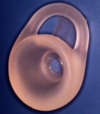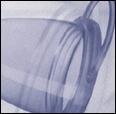






A common method of contraception is to cover the opening of the uterus with a synthetic cup filled with spermicide. Before commercial contraception was readily available, many women used a small piece of natural sponge filled with vinegar. It wasn't very effective, but it helped. The diaphragm, cervical cap, and contraceptive sponge have replaced these early methods. They work in two ways: by providing a physical barrier to semen, and by killing sperm before they can enter the uterus and fertilize an egg. After intercourse the diaphragm, cap, or sponge must be left in place for six hours. These methods may provide considerable protection from sexually transmitted diseases such as gonorrhea, chlamydia, and certain pre-cancerous conditions of the cervix.
The reliability of these methods varies widely, even among women who receive good education about their use and utilize them consistently. For couples who have intercourse frequently, more than three times weekly, these methods may be less effective. Women who have intercourse infrequently, or whose fertility is low because of age, will find barrier methods reasonably reliable. Women who use these methods of contraception are at higher risk of vaginal infection, urinary tract infection, and possibly toxic shock syndrome. For this reason, none of these should be left in place for more than 24 to 48 hours, depending on the method; and, neither the cap nor sponge should be used during menstruation. As with the condom, never use oils or lubricants which are not listed as safe for use with latex because these can damage the diaphragm or cervical cap.
Diaphragm
Average Failure Rate: 20%
The diaphragm is a soft rubber or latex cup that must be fitted for size by your doctor. Spermicide is applied to the diaphragm, which is inserted into the vagina; it covers the cervix and is held securely in place behind the pubic bone and rear wall of the vagina. If intercourse is repeated, contraceptive cream or jelly should be applied each time. This is inserted with a special applicator while the diaphragm is still in place.
Each time the diaphragm is used you should check it for holes or tears, then have it replaced every two years. The diaphragm's size should be checked by your doctor annually, after a pregnancy, and after a gain or loss of more than ten pounds. Consider this method of contraception only if you are committed to following the procedures for using it properly; proper placement is essential.
Cervical Cap
Average Failure Rate:
26-40%
 The cervical cap is a smaller version
of the diaphragm, made of slightly thicker rubber and fitted by
your doctor. The cap, held in place by suction, is partially
filled with contraceptive jelly or cream and then inserted so
that it covers the cervix. If intercourse is repeated, it is
not necessary to reapply spermicide, but you should check to make
sure that the cap is still in place. The cervical cap is as effective
as a diaphragm in women who have not had children, but the higher
failure rates apply to women who have given birth.
The cervical cap is a smaller version
of the diaphragm, made of slightly thicker rubber and fitted by
your doctor. The cap, held in place by suction, is partially
filled with contraceptive jelly or cream and then inserted so
that it covers the cervix. If intercourse is repeated, it is
not necessary to reapply spermicide, but you should check to make
sure that the cap is still in place. The cervical cap is as effective
as a diaphragm in women who have not had children, but the higher
failure rates apply to women who have given birth.
When you first start using the cervical
cap, you should have a Pap test taken within a few months, as
certain types of infections and inflammations are more likely
among users of this device. Some women cannot be fitted for a
cervical cap or cannot easily reach their cervix and must choose
a different form of contraception. Each time you use the cap,
it should be checked for cracks or tears. Replace it if it shows
signs of deterioration. As with the diaphragm, have the fit rechecked
annually and after a pregnancy.
Below are some new types of cervical caps, not yet FDA approved but available from outside the US.
As they are currently being evaluated reliable failure rates are not yet available.

Lea Shield: A silicone version of the cervical cap with a one-way valve, allowing it to be used during menstruation.

The Oves Cervical Cap: A disposable cap, made of hypo-allergenic silicone. Can be worn up to 72 hours.
Contraceptive Sponge
Average Failure: 26-40%
 The contraceptive sponge is a small,
disposable sponge that already contains spermicide. The sponge
should be moistened with water (not saliva) just before inserting,
then placed over the cervix. Once in place, it provides protection
for twenty-four hours, no matter how often you have intercourse.
The contraceptive sponge is a small,
disposable sponge that already contains spermicide. The sponge
should be moistened with water (not saliva) just before inserting,
then placed over the cervix. Once in place, it provides protection
for twenty-four hours, no matter how often you have intercourse.
The sponge is about as
effective as a diaphragm, but, like the cap, it is less effective
for women who have already borne children. In addition to toxic
shock syndrome, women who use the sponge may be at higher risk
of vaginal yeast infections. The Today sponge was removed from the US market in
1995 due to manufacturing problems which were resulting in contamination of
the product. However, other brands are presently available in Canada.

Female Condoms
Average Failure Rate: 21%
 The female condom is a thin polyurethane sheath with two soft
rings at each end. One ring, covered with the polyurethane,
fits over the cervix, acting as an anchor. The larger, open
ring stays outside the vagina, covering part of the perineum
and labia during intercourse.
The female condom is a thin polyurethane sheath with two soft
rings at each end. One ring, covered with the polyurethane,
fits over the cervix, acting as an anchor. The larger, open
ring stays outside the vagina, covering part of the perineum
and labia during intercourse.
As female condoms are relatively new there is only one brand in production. These can be obtained at drug stores or through family planning clinics. Because the condom is not made of latex, it will not deteriorate when used with oil-based lubricants. It can be inserted up to eight hours before intercourse but should be removed immediately after. Some women find the outer ring causes discomfort during use. Male and female condoms should not be used at the same time.

- The following links are provided as an informational resource or counterpoint and are not necessarily endorsed by the author:
- Female Condom
: Order from Drugstore.com
- The Female Health Company: More info about the Reality Female Condom
- Female Condom

Go to next section
Visitors Since 9-5-97

Updated: April 12, 2002
